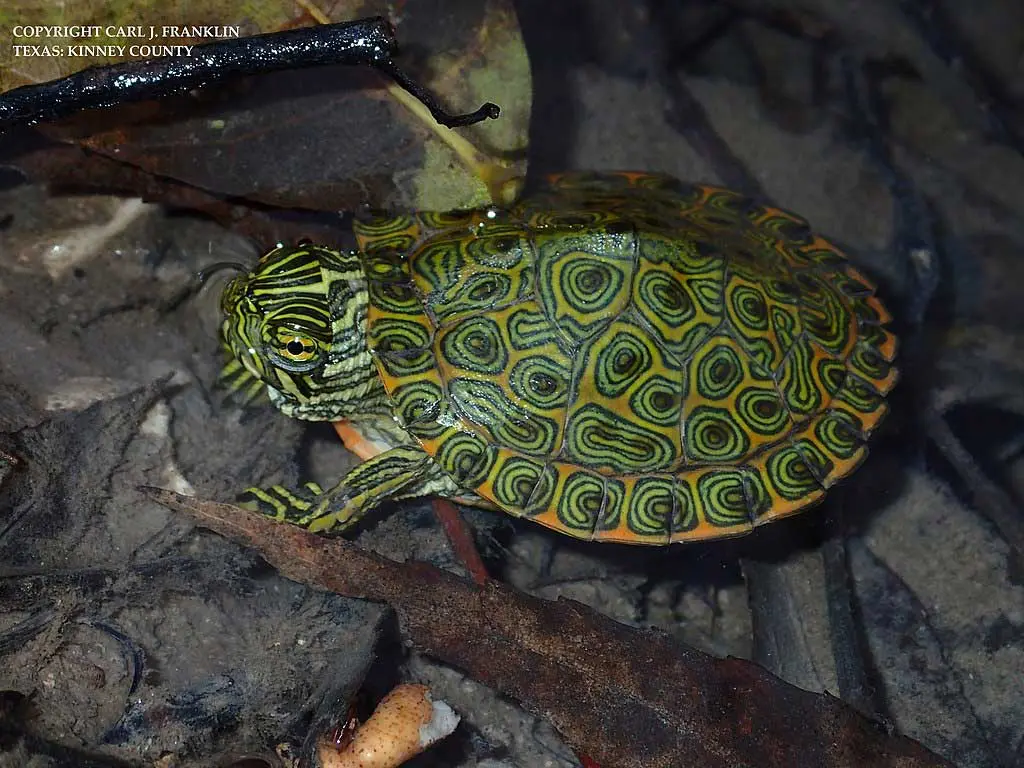
Content |
|---|
Origin / Distribution
The Rio Grande cooter (Pseudemys gorzugi), It lives in Mexico and the United States. It is distributed along the Rio Grande (= Rio Grande do Norte) from the Big Bend region to the Gulf of Mexico; the Pecos River from southeastern New Mexico to its confluence with the Rio Grande, with an apparent gap from just south of the New Mexico border to Independence Creek in Terrell County, Texas; and in the tributary streams of these two rivers in northeastern Mexico (Coahuila, Nuevo León, Tamaulipas and possibly Chihuahua) and in the southwestern United States (New Mexico and Texas).
Characteristics / Appearance
The Rio Grande cooter it is a medium to large sized aquatic turtle with pronounced sexual dimorphism in body size and other characteristics. The carapace of adults is elongated and oval., more convex in males than in females, and has its tallest point near the center and widest just behind the center. The posterior marginals are toothed and the pleurals are shallow.. Males have significantly longer and thicker tails and longer front legs than females..
Habitat

The Rio Grande cooter found in a variety of freshwater habitats. It has a preference for larger and deeper pools in the streams it occupies., normally, but not always, where are aquatic plants. Substrates in their aquatic habitat vary from muddy or sandy to rocky, including algae covered limestone bedrock, and water quality ranges from clear to cloudy.
The species is found at elevations from near sea level in the lower Rio Grande to about 1100 m in southeastern New Mexico
Behavior
The eating habits of Rio Grande cooter have not been well studied, but the species is apparently omnivorous and feeds opportunistically. As with other Pseudemys, adults are probably more herbivorous than young. Specimens captured in New Mexico have been observed feeding on algae that grow on submerged boulders in the Negro River., and often defecated plant matter, especially green algae.
Threats to the species
State of conservation ⓘ |
||
|---|---|---|
 Near Threatened ⓘ
(UICN)ⓘ
Near Threatened ⓘ
(UICN)ⓘ
| ||
The International Union for Conservation of Nature (UICN) has classified the species Pseudemys gorzugi as Near Threatened due to its limited distribution (perhaps less than 2.000 km2), the decline in the quality and quantity of their aquatic habitat and the collection of individuals from wild populations for the pet trade. These multiple threats and other, combined with low genetic diversity and low recruitment of the species, endanger the persistence of the species in many places. In this sense, the Rio Grande cooter is similar to others freshwater turtles from the southwestern United States, facing similar threats.
Predation by other animals appears to affect all life stages of the Rio Grande cooter, from eggs to adults, Although direct evidence is lacking.
The "Rio Grande cooter" in captivity
Aquaterrarium
Smaller individuals can be kept in aquariums or indoor tanks if they are provided with an ultraviolet light source., adults are likely to do better if kept in large open-air ponds or livestock water tanks, equipped with a water circulation and filtration system and with platforms for sunbathing.
The young eat lettuce and other green leafy vegetables., in addition to commercial food for turtles and fish, raw meat and chicken. The pups require ample sunlight or constant exposure to a normal incandescent light bulb to maintain body temperature and induce the formation of vitamin D necessary for proper calcium metabolism.
The young feed on mosquitoes (Gambusia sp.), River Crabs, lettuce, spinach and aquatic plants collected in the wild, and juveniles are fed commercial food such as dry or canned dog food, trout and catfish food or cat food.
Eggs laid in water by captive females can be incubated with excellent results., provided they recover shortly after laying. Depending on the temperature, incubation in captivity can last between 70 and 110 days. You can get a hatching success higher than 90% incubating the eggs in moist newspaper, vermiculite or clean sand.
Buy one "Rio Grande cooter"
The price of a "Rio Grande cooter" at the exotic animal market, ranges between 50 – 80 EUR.
Videos "Rio Grande cooter"
|
|
|
|---|
Alternative names:
1. Rio Grande cooter, Western River Cooter (English).
2. Pseudémyde du Rio Grande (French).
3. Rio-Grande-Schmuckschildkröte (German).
4. Cooter do Rio Grande (Portuguese).
5. "Tortuga del Río Grande", Tortuga de Oreja Amarilla, Jicotéa del Río Bravo, Terrapene del Río Grande (español).
